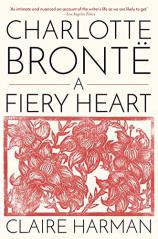Charlotte Brontë: A Fiery Heart
Review
Charlotte Brontë: A Fiery Heart
In October 1847, Currer Bell’s book, JANE EYRE: An Autobiography, was published in England. Of course, “Currer Bell” was the nom de plume of Charlotte Brontë. The novel would dramatically impact not only its readers, but also the style and focus of literature in Charlotte’s own generation and those to come. Jane Eyre was like no heroine any Victorian reader had ever encountered. In fact, the book was related in such a vivid manner that people felt they were reading a description of a woman’s own life --- with thoughts and emotions not so different from their own. Jane’s experiences were indeed patterned after a terribly challenging yet very real life --- Charlotte’s.
Living in the mid-19th century as a middle-class female was neither for the faint of heart nor for the weak of spirit --- or body. Unless a woman had beauty or a dowry, her chances of marriage were slim. And if she had to work, her options were few: governess, teacher, companion. Of course, in Charlotte’s day, the work was punishing and never-ending, with little personal time permitted. For a brilliant, introverted and imaginative woman like Charlotte, it was both grinding and hated.
However, Charlotte and her sisters must work. Their father, Patrick --- an Evangelical minister who was Irish-born and Cambridge-educated (albeit while performing domestic work in exchange for his education) --- and mother, Maria, had six children. Sadly, Maria died while the eldest child was only seven and the youngest an infant. Maria’s sister, Elizabeth (Aunt Branwell), came to live with the Brontës at their Anglican parsonage in Yorkshire. While Aunt Branwell’s presence ensured household order, she never sought to become their loving mother. The five girls, and their much-prized brother, Branwell, were left to their own devices.
"CHARLOTTE BRONTE: A FIERY HEART is by turns charming, devastating, heartbreaking and exciting.... You’ll never look at JANE EYRE the same way again."
Astonishingly, this bore exceptional fruit in the lives of the children, especially for Charlotte, Branwell, Emily and Anne. Patrick Brontë was a talented writer himself, who recommended that those inclined to write fiction refrain from it lest the wonders of their created worlds cause discontent with their everyday lives. As biographer Claire Harman relates, “Patrick Brontë’s children had the run of his books and must have read these words often, but no group of young people ever took less heed of such a warning.” In fact, once they had learned to read and write, they created imaginary worlds, and even wrote prolific miniature books about these worlds and their inhabitants, handwritten by Charlotte in such tiny script that one must use a magnifying glass to read them.
The children’s imaginary playgrounds were interrupted by school. The four elder girls were sent away to the Spartan-esque Cowan Bridge, whose privations destroyed their health and certainly contributed to Maria’s and Elizabeth’s early childhood deaths. Patrick brought Charlotte and Emily home, yet the damage done from the poor nutrition and terrible conditions weakened their health all their lives.
Charlotte’s losses weren’t over, either. A self-described plain and unattractive female, she had no suitors. Years of isolation and living rich, imaginative, indoor lives with her siblings had left her with extreme social discomfort. Her bright, prized brother descended into alcoholism and opium addiction, with all its accompanying deceits and behaviors. Charlotte would endure having to leave her beloved home and the life she shared with her siblings to teach at a girls’ school, a position she hated. And when she finally met a man who lauded, nurtured and appreciated her genius, Monsieur Heger, he was eminently unavailable, being a happily married husband and father.
Finally, Charlotte returned home, where she and sisters Emily and Anne took turns trying to earn additional money for the family. And the suffering each endured, whether it’s the limitations forced upon them because of their plainness, poverty or neglect, is terribly difficult to read about. William Makepeace Thackeray said about Charlotte, “…there’s a fire and fury raging in that little woman a rage scorching her heart…. She has had a story and a great grief that has gone badly with her.” Yet the great griefs of her life have a miraculous outcome, as the beloved Jane Eyre comes to life.
CHARLOTTE BRONTE: A FIERY HEART is by turns charming, devastating, heartbreaking and exciting. Claire Harman has meticulously researched the life of the Brontë family, and of Charlotte in particular, and brought them to life for 21st-century readers. You’ll never look at JANE EYRE the same way again. And you’ll feel nothing but admiration for the author who had to face so many obstacles, yet persevered and succeeded against all odds.
Reviewed by Melanie Reynolds on April 22, 2016
Charlotte Brontë: A Fiery Heart
- Publication Date: February 7, 2017
- Genres: Biography, History, Nonfiction
- Paperback: 496 pages
- Publisher: Vintage
- ISBN-10: 0345803418
- ISBN-13: 9780345803412





